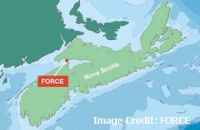Fundy Ocean Research Centre for Energy (FORCE)
Established in 2009 and located in Minas Passage, Bay of Fundy, the Fundy Ocean Research Centre for Energy (FORCE) is North America’s lead research facility for the demonstration of tidal stream technology.
FORCE is designed as a catalyst to the tidal energy sector, providing a technology site, research and monitoring data, and services to help projects advance.
FORCE is a not-for-profit entity that has received funding support from the Government of Canada, the Province of Nova Scotia, and participating developers. The FORCE site is located approximately 10 km west of Parrsboro, Nova Scotia, and includes:
- Ocean berths for tidal energy devices
- Power cables to connect devices to shore
- A substation and power lines to connect to the provincial grid
- A visitor centre open from May to November
FORCE’s ocean site is a 1.6 km x 1.0 km area in the Minas Passage, identified as a “Marine Renewable-electricity Area” under the Province’s Marine Renewable-energy Act.
Resource
The Bay of Fundy pushes roughly 160 billion tonnes of water every tide cycle – equal to four times the combined flow of all the freshwater rivers in the world. The tide speeds up as it pinches through Minas Passage, resulting in 2,500 megawatts of extractable power potential – more than Nova Scotia’s total electricity demand.
In 2012, the Province of Nova Scotia published a strategic target of developing 300 megawatts of tidal stream energy production. At present, FORCE has 30 megawatts of transmission capacity from its onshore substation: at full capacity, this could meet the power needs of roughly 10,000 homes and cut the equivalent GHG emissions of 20,000 cars.
Infrastructure
The FORCE facility is designed to connect tidal energy devices to the provincial power grid. More specifically, its assets include:
- Subsea cables: Four double-armoured, 34.5kV subsea power cables, each 2 to 3 km in length, running from the ocean site to and underground vault at shore.
- Substation: This includes a 30 MW transformer, turbine control bays, switch gear and collector circuits, and revenue class metering.
Transmission lines: 10km of overhead 69kV transmission line connecting the FORCE substation to the provincial power grid near the existing substation in the community of Parrsboro.
Science
FORCE’s science program, which includes both in-house expertise as well as partnerships with world-leaders in marine science, is designed to support informed discussion among policymakers, regulators, rights holders, industry, scientists, and stakeholders. FORCE helps:
- Design and execute monitoring programs
- Support regulatory review and authorization processes
- Bring AI and machine learning to data collection and analysis
- Publish peer-reviewed research in collaboration with academic partners, including Acadia University and Dalhousie University
FORCE has a significant inventory of science equipment to monitor the site, including:
- Acoustic Doppler Current Profilers
- Active acoustic imaging cameras
- C-PODs (and subsurface buoys)
- Conductivity, Temperature & Depth sensors
- Echosounders
- Fish tag acoustic receivers installed throughout Minas Passage
- Hydrophones
- Meteorological station
- Multiplexers, cable termination junction boxes
- Passive acoustic sensors
- Sonar
- Subsea sensor platforms
- Subsea video camera and lighting
- X-band radar
All of FORCE’s monitoring reports are available publicly at https://fundyforce.ca/document-collection.
Engagement
As a shared resource, any tidal activity in the Bay of Fundy must co-exist with many traditional, commercial and recreational users. Public opinion research suggests the vast majority of Nova Scotians support tidal stream energy demonstration; this support depends on public confidence that tidal projects, and their potential impacts, are understood. FORCE regularly engages with:
- Regulators at Fisheries and Oceans Canada and the Nova Scotia Department of Environment and Climate Change
- The local and international scientific community, including academia, Acadia Tidal Energy Institute, Fundy Energy Research Network and independent research organizations
- Senior government representatives, including membership on the federal Task Force on Sustainable Tidal Energy in the Bay of Fundy
- Mi’kmaw organizations: including representation on FORCE’s board and community and environmental monitoring advisory committees, through involvement in FORCE science work, and through regular meetings with the Mi’kmaq Rights Initiative
- The local community: including regular meetings with members of FORCE’s community liaison committee, and an on-site visitor centre, open spring to fall, which has welcomed over 30,000 people.
Technology
To date, a total of five devices have been built for deployment at FORCE: three by OpenHydro; one by Sustainable Marine Energy; one by Occurrent Power.
Eauclaire Tidal has recently partnered with Orbital Marine Power to deploy its technology at FORCE. Orbital currently operates the world’s most powerful tidal turbine in Scotland, the O2: a floating device 74 meters in length, supporting two 1-MW turbines.
For more information on FORCE, visit: https://fundyforce.ca/



